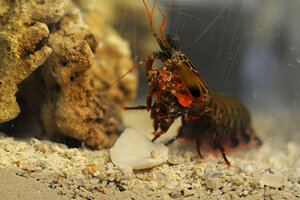How a shrimp's 200-lb. punch could lead to better football helmets
Scientists have marveled at how the mantis shrimp breaks open its prey, but only now are engineers learning how the shrimp's club is built – and how that could help humans.

Study of how the mantis shrimp attacks its prey could lead to human applications.
Carlos Puma
A shrimp? A shrimp? You talkin' to me?
Tread lightly around the mantis peacock shrimp. Up to 7 inches long, this crustacean sports gregarious colors – and an extraordinarily powerful, resilient club for whacking its prey.
Now, a team of scientists has uncovered the secrets of the club's construction, unrolling a blueprint that holds the promise of a new generation of lightweight, impact- and shock-resistant materials for products ranging from body armor and electric cars to football helmets that better shield players from head injuries.
Indeed, the researchers already have designed composite materials based on the club's natural design that have successfully withstood several types of high-velocity munitions, says David Kisailus, an assistant professor of engineering at the University of California at Riverside, who along with colleagues from six other institutions conducted the study.
The peacock mantis shrimp feeds on some of the hardest nuts to crack in the ocean – snails, other crustaceans, as well as other forms of shellfish. It does so by unleashing its club repeatedly at unusually high speeds until the shells of its prey crack open enough to expose the shrimp's meal.
How it does this is crucial to understanding the enormous stresses it is able sustain.
Like a praying mantis, the shrimp have a folded appendage near their heads. The appendage resembles a football punter's tightly draw leg just before he unleashes the kick. The appendage has a latch that locks the joint until a muscle in the upper portion of the appendage has fully contracted. When the shrimp releases the latch, it unleashes the pent-up energy in the muscle, flinging the appendage outward, explains Shelia Patek, a biologist at the University of Massachusetts at Amherst, who uncovered a spring-like material at the joint that further energizes the strike.
Dr. Patek and fellow researchers have clocked the shrimp's punt at more than 45 miles an hour – underwater. That makes it the new world champ for so-called feeding strikes – the movement animals make to nail their prey. It's nearly twice as fast as a punch a boxer typically throws in open air and delivers a force of more than 200 pounds, with the club accelerating with a force of some 10,000 Gs – 500 times more acceleration force than humans can endure.
And that isn't all. Patek's team also found that the strike imparted a second rattling impulse to a creature's shell that came quickly on the heels of the first strike. When the researchers examined high-speed video, they saw a brief flash of light at the point of contact – the telltale signs of cavitation.
Cavitation is a destructive process marine engineers know well. In this case, the club is moving so fast that it creates an area of intense low pressure between the club tip and the object it's striking. The water there literally vaporizes, forming a bubble that quickly collapses, generating sound, light, heat, and its own impact with a force comparable to the impact from the shrimp's club.
When Dr. Kisailus was hunting for natural materials that could help humans engineer better materials, he and colleague James Weaver, now with Harvard University's Wyss Institute for Biologically Inspired Engineering, came across the research.
"We're, like, wow!" recalls Dr. Kisailus.
So the team went to work analyzing the club's structure and composition. The results appear in the June 8 issue of the journal Science.
One surprising discovery was that the club is not one uniform unit but is composed of three regions, Kisailus says.
The business end of the club, which bears the brunt of the impact, held surprises of its own. It consists of layers made from the same mineral found in human bones – hydroxyapatite.
The layers resist up to twice as much compression as some of the best industrial ceramics today, Kisailus says. The industrial ceramics are made at temperatures of 1,500 degrees Celsius, while the shrimp's club tip forms essentially at room temperature.
"That's impressive," he says.
Behind the club's tip is another region, consisting of fibers made from complex sugars. The fiber is known as chitin, and it's arranged in stacked layers, with each offsetting slightly from the layer below. Spaces in between layers are filled with calcium phosphate and calcium carbonate.
The layer can crack, but the construction makes it extremely difficult for the crack to propagate through the region, meaning it "absorbs a lot of energy" without failing, Kisailus says. In fact, the arrangement is so intricate, and the potential pathways for cracking so labyrinth-like, that a crack literally would have to travel for miles to traverse the region, he says.
The final region consists of chitin fibers that wrap around the club, much like a boxer tapes his hands. When the shrimp's club strikes a shell, the club tip not only compresses, it also tries to spread laterally. The fiber wrapping prevents this, keeping any crack that forms from growing wider.
The marvel, Kisailus says, is nature's engineering approach.
Human engineers tend to design materials that are so strong that they resist breaking, he says, "but when they do break, they fail catastrophically. "Nature makes things so that they can break, but they are not going to break catastrophically."

